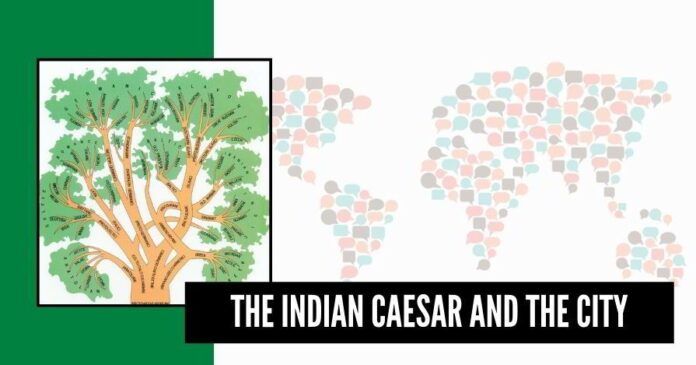
The title Kesarī was used in India in the same manner as the Roman Caesar from which Kaiser (German) and Tsar or Czar (Russian) are derived.
I am told that one of the pleasures of savouring wine is in the struggle for words to describe the bewildering mix of flavour and aroma. This pleasure lies in the choosing of names for a complex experience.
If what I have just said is correct — I can only guess for I am a teetotaler, but I am told this by friends who spend enormous amounts of money on wine—, then this pleasure is similar to determining the exact meaning associated with words and finding their earliest forms. This is because many words code subjective experience that is not quite the same for the speaker and the listener.
Linguists study words as part of their research, and they develop etymologies by going back into history. But these are not always good or plausible stories, and sometimes they leave out connections that the linguist (story-teller) may be unaware of.
The list below, which is by no means exhaustive, show that many different words were used for the city in different languages of Europe.
Not much attention has been given to the fact that many words current in various lands of Eurasia are to be found in Sanskrit. I call this little-studied phenomenon in vocabulary diversity. In an earlier post, I showed how different words for water that vary across Eurasia are present in Sanskrit, and I showed this was true for many other randomly chosen words also. Even though our examples were mostly for Indo-European language family words, some of them could be enlarged to include a few other languages on the Eurasian continent.
Indo-European languages
Linguists speak of a conjectured mother language, called Proto-Indo-European (PIE), from which the daughter languages emerged. But the logic behind the idea of PIE and its conjectured etymologies is circular and, therefore, quite unscientific. It assumes a certain direction of evolution and dispersal and then hypothesizes words and then confirms this process in the evolved words. Such circularity is similar to that of the religious doctrine of creationism. But the fact that so many scholars have devoted their life-time to it should not surprise us, for scholars can be as irrational as common folk (see, for example, the life of Newton who spent many years on alchemy and biblical chronology).
Another error in the idea behind PIE is the hypothesis of a single mother language of the remote past that later devolved into many. I personally think that the ancient world was much more complex than assumed (quite like the linguistic diversity of the Americans when the Europeans arrived) and to look for a single original home of the Indo-European languages is wrong.
The Indo-European languages are also deeply connected with the Uralic, Altaic, Afro-Asiatic and Dravidian languages and perhaps looking at the overarching Nostratic family makes greater sense. This is not to mean that there was a mother-Nostratic language like the imagined PIE, but rather there were overlapping interactions that eventually ended up in the families that we know.
Caesar and Kesarī
Indian kings used the title Kesarin केसरिन् or Kesarī (for lion), and a dynasty that ruled in east India for three centuries was called Kesarī. The title Kesarī was used in India in the same manner as the Roman Caesar (Latin pronunciation = ˈkae̯.sar) from which Kaiser (German) and Tsar or Czar (Russian) are derived. There is no evidence that the usage in India was borrowing from Rome.
Pliny derives Caesar from caesaries or “full head of hair” because the future ruler was born thus. The word was elevated to a title after Caius Julius Caesar (100 BCE — 44 BCE) became a dictator and later it was used by emperors down to Hadrian (138 CE).
In Sanskrit, the word Kesarin (having a mane) comes from the word Kesara, one of whose meanings is hair. Male lions, horses and some monkeys have mane, so each of them can be called by this word. In the plant kingdom, Kesara refers to a filament of any flower and thus to saffron. But mostly Kesarī केसरी means a lion. An equivalent title in India that was used by kings is that of Siṃha सिंह, which is familiar to all in the spelling “Singh”. In the Rāmāyaṇa, the father of the hero Hanuman is Kesarī.
The correspondence between Sanskrit and Latin for this word is quite striking. Is it just the word derived from the non-existent mother language or obtained through diffusion? We know that there was commerce between ancient India and Rome so the idea of diffusion in both directions cannot be ruled out.
The city and the land
Now we come to the names of the city in Sanskrit, which could also be a place, a fort, an enclosure, and so on.
उम, uma (town) — Umā (of the Mountain [City])
उरु, uru (wide protected space) — var (fort, Iranian); oras (name of a town in Romania and Moldova)
कीला, kīlā (stake) — the basis of किला, kilā (fort)?
कर्वट, karvaṭa (capital of 200 to 400 villages, city) — civitus (Latin) pronunciation: kiːwɪtaːs), was the social body of the civic, or citizens, united by law (concilium coetusque hominum jure sociati); citta (Italian); city (English)
कोट, koṭa (fortress) — as in Rajkot. Kot (کوت) is a district in the northern Nangarhar Province of Afghanistan. A kot is a type of privately rented rooms during the academic or school year in Belgium.
ग्राम, grāma (village) — Gurugrama
क्षा, kṣā(abode) — kṣatra क्षत्र (power) => Khotanese, kṣāra => shahar (Persian), shire (English)
गर्त, garta (high enclosed place) — गढ, gaḍha (fort) — gorod (Russian)
देश, deśa (region from diś, direction) — Bangladesh
दुर्ग, durga (fort) — Ilādurga (name of a place), Durg district
नगर, nagara (city) — Srinagar in Kashmir
पट्टी, paṭṭī (town) — पट्टनिवसन (a town-dweller)
पत्तनम्, pattanam (town, city) — Vishakhapatnam in Andhra Pradesh
पल्लि, palli (town, city) –Tiruchirappalli, Maṇipalli
पुर, pura (fortified city, citadel) — polis (Greek), Heliopolis in Egypt, Persepolis in Iran, Sevastopol in Crimea, Indianapolis in USA
पाद, pāda (quarter; as in Viṣṇupāda) — –bād or –ābād (آباد), meaning cultivated place (Farsi), Ashgabat in Turkmenistan, Abbottabad in Pakistan
बिल, bila (cave) — ville (Latin) for farm and later village, as in Louisville in Kentucky; by (farm, town) in Norwegian
भर्ग, bharga (bright place)– borgh (Old Swedish). Borg is a German village in the municipality of Perl, Saarland
राण्ड्य, rāṇḍya (agreeable [country]) — RV 6.23.6, we know of the transposition between “l” and “r” as in lekhā and rekhā=> lāṇḍya=> land (English)
वाट, vāṭa (enclosure) — As in Angkor Wat (Cambodia)
वेष्टन, veṣṭana (enclosed) — (also note the “v” to “m” transposition in Sanskrit as in varma and marma) — mesto (Czech, Slovak, Slovenian), Staré Město in the Czech Republic
स्थान, sthāna (place, land, city) — stāna (Hindi) as in Londonistan or Gamlastan in Stockholm, Stanmore in UK; –ston => -ton as in Paddington (UK)
स्थल, sthala (land) — –ster, as in Lybster in UK
स्थात्र, sthātra (station, land) — stadt (German), Hampstead in UK
स्वतन, svatana (own land) — hvatana (Khotanese) => vatan (Kashmiri, Turkish)
and there are many more words for town and city in Sanskrit.
Vocabulary diversity again
The above list, which is by no means exhaustive, show that many different words were used for the city in different languages of Europe. That this diversity is subsumed in Sanskrit goes counter to the standard picture of the Indo-European family in which just one group went from its Urheimat towards India.
Reference
Sanskrit words for water, house, mountain, sky, divinity, and so on.
Note:
1. Text in Blue points to additional data on the topic.
2. The views expressed here are those of the author and do not necessarily represent or reflect the views of PGurus.
- A Very Brief History of Indian Science - March 20, 2020
- Indian Foundations of Modern Science - March 16, 2020
- An Indian Classics Curriculum - December 31, 2019










